Introduction
Carbure sont un élément clé de l'industrie de l'usinage, car elles offrent une dureté, une durabilité et une efficacité de coupe inégalées. Cependant, toutes les pointes brasées en carbure ne se valent pas. Le type spécifique de carbure utilisé peut avoir une incidence considérable sur les performances de l'outil. Il est donc essentiel de comprendre les différences de propriétés entre les divers types de pointes. Dans ce blog, nous allons nous pencher sur les différents types de pointes brasées en carbure, leurs propriétés uniques et leur comparaison. À la fin, vous serez bien équipé pour choisir le bon type en fonction de vos besoins spécifiques.
Que sont les pointes brasées au carbure ?
Les pointes en carbure brasées sont des outils de coupe fabriqués en attachant un morceau de carbure à un corps en acier par un procédé de brasage. Cette combinaison met à profit la dureté et la résistance à l'usure du carbure avec la flexibilité et la ténacité de l'acier, ce qui rend ces outils idéaux pour diverses opérations d'usinage.
Propriétés clés des pointes brasées en carbure
Il est essentiel de comprendre les propriétés clés qui définissent les performances des pointes brasées en carbure. Voici les principales caractéristiques à prendre en compte :
- Dureté : La capacité à résister à la déformation et à l'usure.
- La robustesse : La capacité d'absorber les chocs et de résister à l'écaillage.
- Résistance à l'usure : La capacité de résister à l'usure abrasive.
- Stabilité thermique : La capacité de maintenir les performances à des températures élevées.
- Résistance à la corrosion : La capacité à résister aux attaques chimiques et à l'oxydation.
Types de pointes brasées au carbure
1. Grade C1 : polyvalent
Propriétés :
- Dureté : Moyen
- La robustesse : Haut
- Résistance à l'usure : Bon
- Stabilité thermique : Modéré
- Résistance à la corrosion : Modéré
Applications :
- Usinage général des métaux non ferreux, des matières plastiques et du bois.
- Convient aux opérations légères à moyennes.
2. Qualité C2 : Polyvalent et résistant à l'usure
Propriétés :
- Dureté : Haut
- La robustesse : Modéré
- Résistance à l'usure : Très élevé
- Stabilité thermique : Bon
- Résistance à la corrosion : Bon
Applications :
- Usinage de la fonte, des métaux non ferreux et des matériaux non métalliques.
- Idéale pour les travaux de moyenne envergure avec un accent particulier sur la résistance à l'usure.
3. Qualité C3 : Dureté élevée pour la précision
Propriétés :
- Dureté : Très élevé
- La robustesse : Inférieur à C1 et C2
- Résistance à l'usure : Excellent
- Stabilité thermique : Haut
- Résistance à la corrosion : Modéré
Applications :
- Usinage de précision des matériaux durs et abrasifs.
- Convient aux opérations de finition nécessitant une qualité de surface élevée.
4. Qualité C4 : résistance extrême à l'usure
Propriétés :
- Dureté : Extrêmement élevé
- La robustesse : Faible
- Résistance à l'usure : Supérieure
- Stabilité thermique : Très élevé
- Résistance à la corrosion : Bon
Applications :
- Usinage intensif d'alliages durs, d'aciers à outils et de matériaux trempés.
- Excellent pour les applications nécessitant une résistance extrême à l'usure.
5. Note C5 : performance équilibrée
Propriétés :
- Dureté : Haut
- La robustesse : Haut
- Résistance à l'usure : Haut
- Stabilité thermique : Bon
- Résistance à la corrosion : Haut
Applications :
- Usinage polyvalent d'une large gamme de matériaux.
- Convient aux opérations d'ébauche et de finition.
6. Grade C6 : haute ténacité
Propriétés :
- Dureté : Modéré
- La robustesse : Très élevé
- Résistance à l'usure : Bon
- Stabilité thermique : Modéré
- Résistance à la corrosion : Modéré
Applications :
- Opérations d'usinage impliquant des coupes interrompues et des charges lourdes.
- Idéal pour les opérations d'ébauche où la ténacité est essentielle.
7. Catégorie C7 : thermiquement stable
Propriétés :
- Dureté : Haut
- La robustesse : Modéré
- Résistance à l'usure : Haut
- Stabilité thermique : Supérieure
- Résistance à la corrosion : Bon
Applications :
- Usinage à grande vitesse et opérations générant une chaleur importante.
- Convient à l'usinage des alliages à haute température et des matériaux trempés.
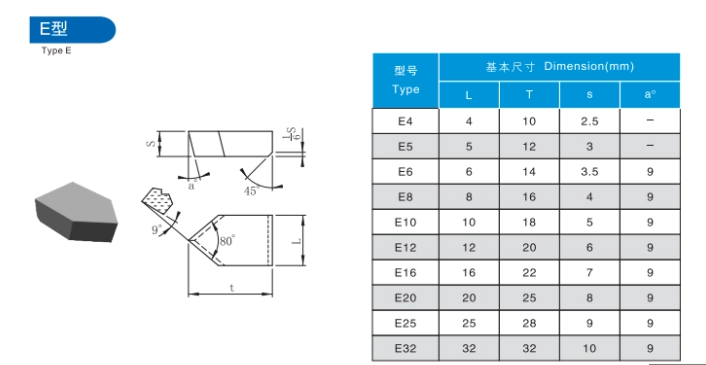
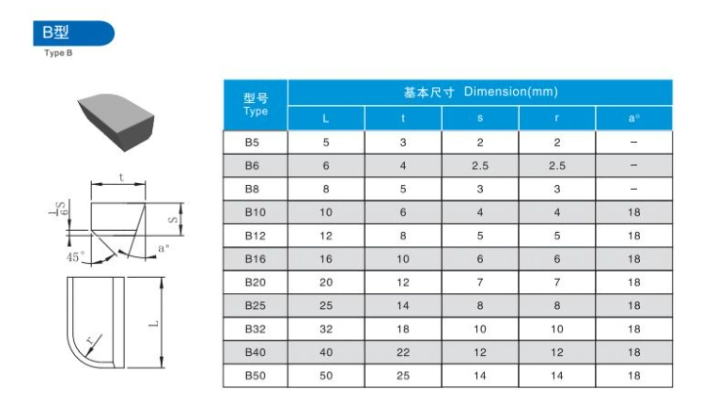
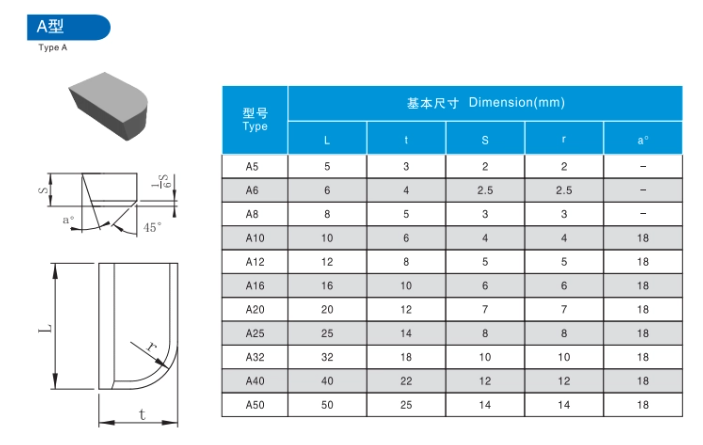
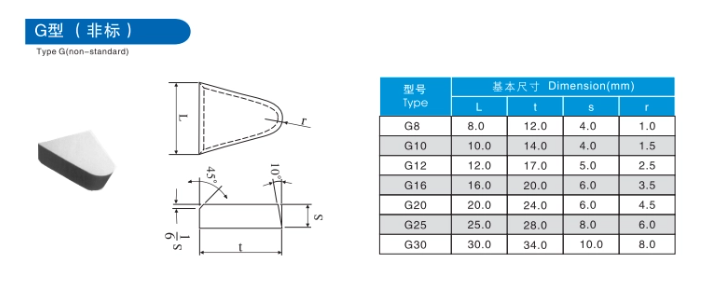
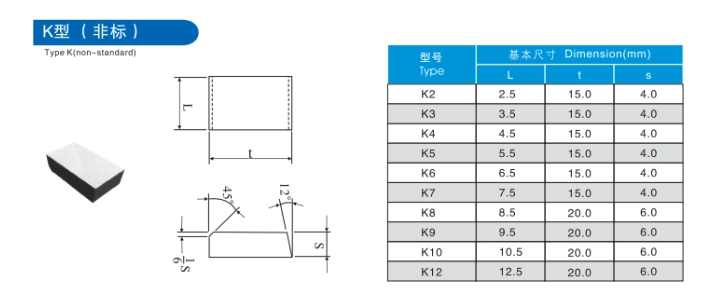
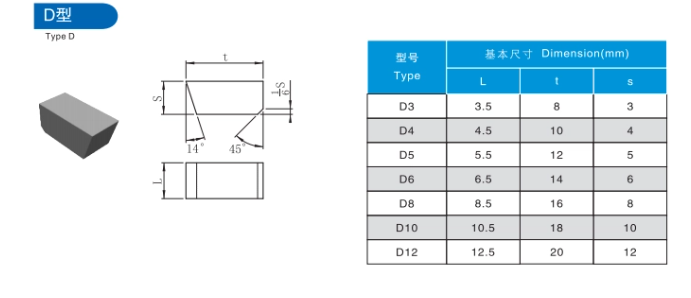
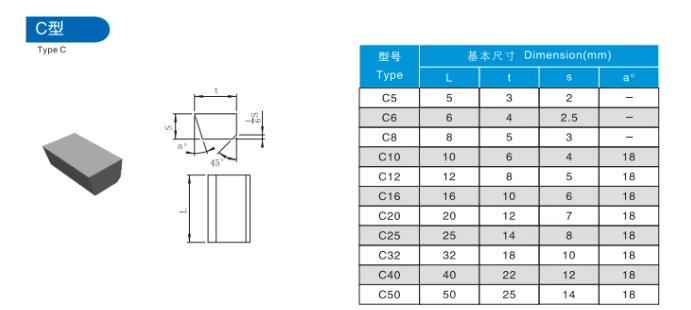
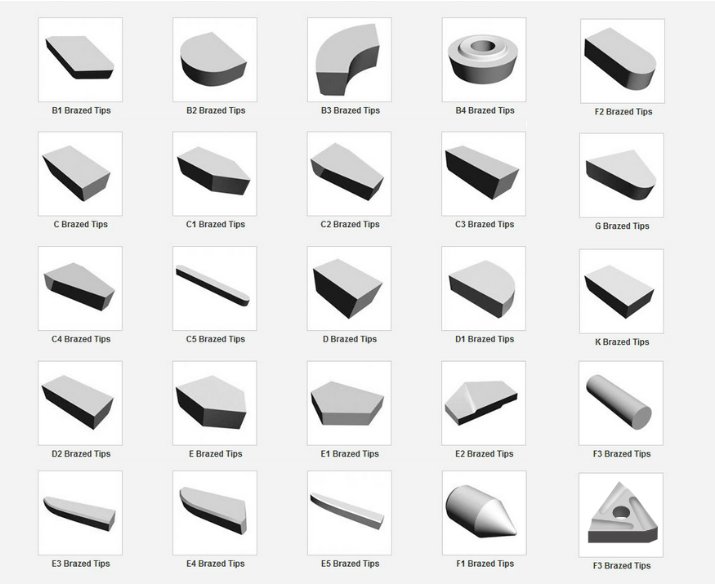
Analyse comparative des pointes brasées au carbure
Pour mieux comprendre comment ces pointes brasées en carbure se comparent, examinons une analyse comparative de leurs principales propriétés :
| Propriété | C1 | C2 | C3 | C4 | C5 | C6 | C7 |
|---|---|---|---|---|---|---|---|
| Dureté | Moyen | Haut | Très élevé | Extrêmement élevé | Haut | Modéré | Haut |
| Solidité | Haut | Modéré | Plus bas | Faible | Haut | Très élevé | Modéré |
| Résistance à l'usure | Bon | Très élevé | Excellent | Supérieure | Haut | Bon | Haut |
| Stabilité thermique | Modéré | Bon | Haut | Très élevé | Bon | Modéré | Supérieure |
| Résistance à la corrosion | Modéré | Bon | Modéré | Bon | Haut | Modéré | Bon |
Tableau 1 : Analyse comparative des pointes brasées au carbure
Choisir le bon embout brasé au carbure
Le choix de la pointe brasée en carbure appropriée dépend de plusieurs facteurs, notamment du matériau usiné, du type d'opération et des exigences spécifiques de l'application. Voici quelques conseils pour vous aider à choisir le bon type de pointe :
1. Matériau usiné
- Métaux non ferreux et plastiques : Les grades C1 ou C2 conviennent en raison de leur bonne ténacité et de leur résistance à l'usure.
- Fonte et matériaux non métalliques : Les grades C2 ou C3 offrent une dureté et une résistance à l'usure élevées.
- Alliages durs et matériaux trempés : Les grades C4 ou C7 offrent une résistance à l'usure et une stabilité thermique supérieures.
2. Type d'opération
- Opérations d'ébauche : Les nuances C5 ou C6 sont idéales pour leur haute ténacité et leur capacité à supporter de lourdes charges.
- Opérations de finition : Les qualités C3 ou C4 sont préférables pour leur grande dureté et leur précision.
- Coupes interrompues : La nuance C6 est appropriée en raison de sa très grande ténacité.
3. Exigences en matière d'application
- Usinage à grande vitesse : La qualité C7 est recommandée pour son excellente stabilité thermique.
- Usinage de précision : La qualité C3 offre la dureté et la résistance à l'usure nécessaires pour des finitions de haute qualité.
- Utilisation générale : Les grades C1 ou C5 offrent un équilibre de propriétés pour une large gamme d'applications.
Avantages de l'utilisation du bon embout brasé en carbure
Le choix d'une pointe en carbure brasée adaptée à vos opérations d'usinage présente de nombreux avantages :
- Amélioration de la durée de vie des outils : La nuance de carbure appropriée garantit une plus longue durée de vie de l'outil, réduisant ainsi la fréquence des changements d'outils et de l'entretien.
- Amélioration des performances de coupe : Une dureté et une résistance à l'usure optimales se traduisent par de meilleures performances de coupe et des finitions de meilleure qualité.
- Augmentation de la productivité : La réduction des temps d'arrêt et de la maintenance entraîne une augmentation de la productivité et des économies.
- Polyvalence : Le choix de la qualité appropriée vous permet de manipuler facilement une large gamme de matériaux et d'applications.
- Le rapport coût-efficacité : La bonne qualité minimise l'usure et la casse des outils, ce qui permet de réduire les coûts globaux.
Conclusion
Comprendre les différents types de pointes brasées au carbure La connaissance des matériaux et de leurs propriétés est essentielle pour optimiser vos opérations d'usinage. Chaque type offre une combinaison unique de dureté, de ténacité, de résistance à l'usure, de stabilité thermique et de résistance à la corrosion, ce qui les rend adaptés à des applications et à des matériaux spécifiques. En choisissant la bonne pointe brasée en carbure, vous pouvez obtenir des performances de coupe supérieures, une durée de vie d'outil plus longue et une productivité accrue. Que vous usiniez des métaux non ferreux, des alliages durs ou des matériaux à haute température, il existe une pointe brasée en carbure adaptée à vos besoins. Faites des choix éclairés et découvrez les avantages inégalés de l'utilisation de pointes brasées en carbure adaptées à vos opérations.




